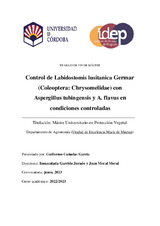Mostrar el registro sencillo del ítem
Control de Labidostomis lusitanica Germar (Coleoptera: Chrysomelidae) con Aspergillus tubingensis y A. flavus en condiciones controladas
| dc.contributor.author | Cañadas García, Guillermo | |
| dc.date.accessioned | 2024-04-17T10:19:13Z | |
| dc.date.available | 2024-04-17T10:19:13Z | |
| dc.date.issued | 2024 | |
| dc.identifier.uri | http://hdl.handle.net/10396/27930 | |
| dc.description | Premio extraordinario de Trabajo Fin de Máster curso 2022/2023. Máster Universitario en Protección Vegetal. | es_ES |
| dc.description.abstract | Las especies de hongos del género Aspergillus muestran una gran diversidad de hábitos de vida. En su mayoría son hongos saprófitos de suelo, pero algunos de ellos han mostrado ser entomopatógenos. En el presente trabajo fin de máster (TFM) se ha identificado morfológica y molecularmente una cepa de la especie Aspergillus tubingensis Mosseray (Ascomycota: Aspergillaceae) (FIT-22014) aislada de adultos de clitra, Labidostomis lusitanica Germar (Coleoptera: Chrysomelidae), una de las principales plagas del pistachero en España. El aislado FIT-22014 ha mostrado capacidad entomopatógena en larvas de Galleria mellonella L. (Lepidoptera: Pyralidae). La patogenicidad de la cepa FIT-22014, ha sido comparada con la mostrada por tres cepas atoxigénicas (no productoras de aflatoxinas) de la especie A. flavus (ASP041, ASP040 y ASP026) seleccionadas previamente según su capacidad para reducir micotoxinas (aflatoxinas) en frutos de pistachero. Inicialmente, la caracterización morfológica de la cepa FIT-22014 se realizó atendiendo a la morfología del conidióforo y los conidios, mientras que la caracterización molecular se abordó a través de la secuenciación de las regiones ITS, BT2 y CMD. El ensayo de patogenicidad confirmó que las cuatro cepas son entomopatógenas, si bien todos mostraron mortalidades inferiores al 50%. La cepa ASP041 de A. flavus fue la que redujo más la población de G. mellonella al producir 28.57% de mortalidad total y un 3.33% de pupas malformadas. La cepa FIT-22014 de A. tubingensis, que fue la aislada de los adultos de L. lusitanica, presentó un 17.24% de mortalidad total, y un 3.67 y 3.33% de adultos y pupas malformadas. En este trabajo se describe por primera vez A. tubingensis como agente entomopatógeno. Además, cabe destacar que el empleo de cepas atoxigénicas de A. flavus podría utilizarse con un doble propósito, reducir el contenido de aflatoxinas en pistachos y controlar fitófagos, disminuyendo así los costes de producción dentro de una estrategia de control integrado de plagas y enfermedades. | es_ES |
| dc.description.abstract | Fungal species of Aspergillus genus show a great diversity of lifestyles. Most of them are saprophytic soil fungi, but onlyfew have shown entomopathogenicity. In the present master's tesis (TFM), the strain FIT-20014 of A. tubingensis isolated from leaf beetle adults, Labidostomis lusitanica Germar (Coleoptera: Chrysomelidae), was indentified morphologically and molecularly. This insect is one of the main pests of pistachio trees in Spain. The FIT-22014 isolate exhibited entomopathogenic capacity against Galleria mellonella L. (Lepidoptera: Pyralidae) larvae. The pathogenicity of the FIT-22014 strain was compared whith three atoxigenic strains (not aflatoxins producers) of A. flavus (ASP041, ASP040 and ASP026), that they were previously selected based on their ability to reduce the mycotoxins (aflatoxins) in pistachio nuts. The morphological characterization of the FIT-22014 strain was carry out based on the morphology of the conidiophore and the conidia, while the molecular characterization was approached through the sequencing of the ITS, BT2 and CMD regions. The pathogenicity assay confirmed that the four strains are entomopathogenic, although their mortalities were lower than 50%. The A. flavus strain ASP041 obtained the higher reduction of G. mellonella population 28.57% of total mortality and 3.33% of malformed pupae. The A. tubingensis strain FIT-22014, which was isolated from L. lusitanica adults, showed 17.24% of total mortality, and 3.67% and 3.33% malformed adults and pupae, respectively. In this study, A. tubingensis is described for the first time as an entomopathogenic fungus. Furthermore, it should be noted that the use of atoxigenic strains of A. flavus could have a dual purpose, reducing the content of aflatoxins in pistachios and controlling phytophagous pests, thus decreasing production costs within an integrated pest and disease control strategy. | es_ES |
| dc.format.mimetype | application/pdf | es_ES |
| dc.language.iso | spa | es_ES |
| dc.publisher | Universidad de Córdoba | es_ES |
| dc.rights | https://creativecommons.org/licenses/by-nc-nd/4.0/ | es_ES |
| dc.subject | Aspergillus tubingensis | es_ES |
| dc.subject | Aspergillus flavus | es_ES |
| dc.subject | Galleria mellonella | es_ES |
| dc.subject | Labidostomis lusitanica | es_ES |
| dc.subject | Control de enfermedades | es_ES |
| dc.subject | Enfermedades y plagas | es_ES |
| dc.subject | Hongos entomopatógenos | es_ES |
| dc.subject | Disease control | es_ES |
| dc.subject | Diseases and pests | es_ES |
| dc.subject | Entomopathogenic fungi | es_ES |
| dc.title | Control de Labidostomis lusitanica Germar (Coleoptera: Chrysomelidae) con Aspergillus tubingensis y A. flavus en condiciones controladas | es_ES |
| dc.type | info:eu-repo/semantics/masterThesis | es_ES |
| dc.rights.accessRights | info:eu-repo/semantics/openAccess | es_ES |
| dc.contributor.tutor | Garrido-Jurado, Inmaculada | |
| dc.contributor.tutor | Moral, Juan |

